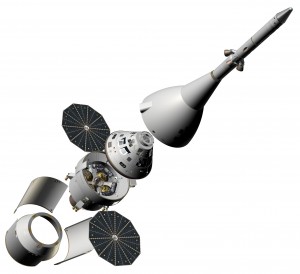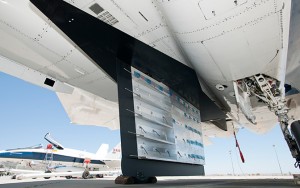Posts Tagged ‘NASA’
The Cygnus/Antares Launch
In a September full of test launches (Minotaur V and Epsilon), here’s the latest offering: Orbital Sciences’ Cygnus cargo craft on the Antares rocket making its first demonstration flight to the International Space Station. With this, Orbital Sciences aims to be the second private company cleared for cargo transfers to the ISS, after SpaceX.
I like the Antares rocket launches because we get camera views of stage separation. On the first Antares launch, we got camera of the payload fairing separation as well – a relative rarity – but we didn’t get that this time.
Here’s the video of today’s launch, which occurred at 7:58 a.m. PST:
Two Truly Spectacular Maiden Flights – Minotaur V and Epsilon
It’s pretty rare that we get two magnificent new launch vehicles getting their first flight within a week of each other, but that’s what happened with the LADEE/Minotaur V launch on Sept. 7th and the SPRINT-A/Epsilon launch on Sept. 14th. Both rockets use a series of solid stages to boost their payload – the Minotaur V puts 630 kg into geosynchronous transfer orbit or, in the case of LADEE, 437 kg into trans-lunar trajectory, while the Epsilon puts 1200 kg into low Earth orbit.
The benefit to solid stages are that they are cheap and relatively non-volatile (unlike cryogenic fuels). As you’ll see in the videos, they also get going rather quickly (that is, they have a very high thrust-to-weight ratio). The downside is that they are relatively inefficient in terms of ISP, and so aren’t suited to heavy loads in the upper atmosphere/space. They are also not throttled and lack the safety features of liquid rockets, so they aren’t used for manned flights.
Without further ado, there are the spectacular videos of the launches:
Astronaut Chris Cassidy Explains the Helmet Leak
If you’ve been following space news at all recently, you probably heard that on an ISS spacewalk, there was a malfunction in astronaut Luca Parmitano’s suit that led to water slowly leaking into his helmet. The flow was such that they were able to take a measured approach to considering the situation and getting Parmitano back inside the station (and even take some photos while ground control was mulling over the issue), but it could easily have been much more desperate if the flow had been worse.
I don’t know about you, but I’ve been eager to hear an explanation on what happened, and NASA has just released a video from Luca’s companion on the spacewalk, Chris Cassidy. So, here’s what we know so far:
It sounds like, for now, the rest of the spacewalk hasn’t been rescheduled. There’s no telling how long it will be before they can certify that the problem won’t recur on other suits or come up with a fix. It’s already been quite a while, and I’m a bit disheartened to hear that they haven’t figured it out to the extent that they can get a new spacewalk scheduled.
NASA’s Orion Spacecraft
The Orion spacecraft is the vehicle NASA plans to use to extend the reach of manned spaceflight beyond Low Earth Orbit. Originally, it would have been perched on top of the Ares I launch vehicle, which was tested . . . but then canceled. Now, it will be on top of the Delta IV Heavy rocket for missions to LEO – like getting crew to the International Space Station – and eventually boosted up by the Space Launch System for more far-flung destinations.
The basic stats for the spacecraft are as follows:
Diameter: 5m
Habitable Volume: 316 cubic feet (8.95 cubic meters)
Capsule Mass: 8913 kg
Service Module Mass: 12337 kg (7907 kg propellant)
Crew: 2-6
Delta-V: 1595 m/s
Endurance (with current service module configuration): 21.1 days
Using 3-D Printers to Make Rocket Parts? Done.
Yes, according to this July 24th article on NASA’s website, not only can they manufacture injectors using 3-D printers at a substantially cheaper cost than by traditional methods, but the 3-D printed parts actually perform better. You can get all the juicy details from the NASA article – as usual, I’d like to talk about the broader implications. But first, how about a video of the part at work, enduring the 6,000 degree Fahrenheit temperatures it needs to:
Sometimes, NASA seems to be going at a snail’s pace that drives me nuts, but it looks like they’re on the cutting edge here, along with SpaceX, which is also using 3-D printers to make their parts.
Of course, every science fiction enthusiast has to be thinking replicators, right? And this is definitely going to be another case of science fiction becoming science fact, but let’s think about what this means for the next generation or so without getting all Star Trek about it. Think about Mars, or any future space base. Now, if something goes wrong, they won’t need the part manufactured on Earth and set on a potentially months-long delay. Instead, they’ll be taking a 3-D printer and some raw materials with them, and if they need to replace a part, they can manufacture it on-site without delay. This dramatically reduces the risks to any people we choose to send out there – especially for those sent to Mars.
NASA Orion Spacecraft Parachute Test
In case you missed it, this is NASA’s livestream of the test of the Orion parachute system by dropping it from 35,000 feet on July 24th, 2013:
Just a warning: the sound quality is absolutely horrendous. People commenting on the livestream suggested that someone connected to the Google Hangout left their mike on. Anyway, if Orion ends up going to Mars, then this would be the equivalent to watching the parachute tests on the Apollo CSM – not to be missed.
I’ll do a write-up with more details of the Orion spacecraft soon.
Mysteries of the Supersonic Investigated
Almost sixty-five years after Chuck Yeager broke the sound barrier, there’s still a lot we don’t know about supersonic aerodynamics, especially with transonic airflows. In designing supersonic aircraft, engineers often stick with what works in terms of airfoils and manufacturing specifications. With the development of stronger and lighter materials, however, it may be possible to create more innovative designs.
In order to test what might be possible, NASA’s Dryden Flight Research Center is conducting Supersonic Boundary Layer Transition (SBLT) tests in partnership with Aerion Corporation. Here’s the instrument pylon underneath a Dryden F-15B:

